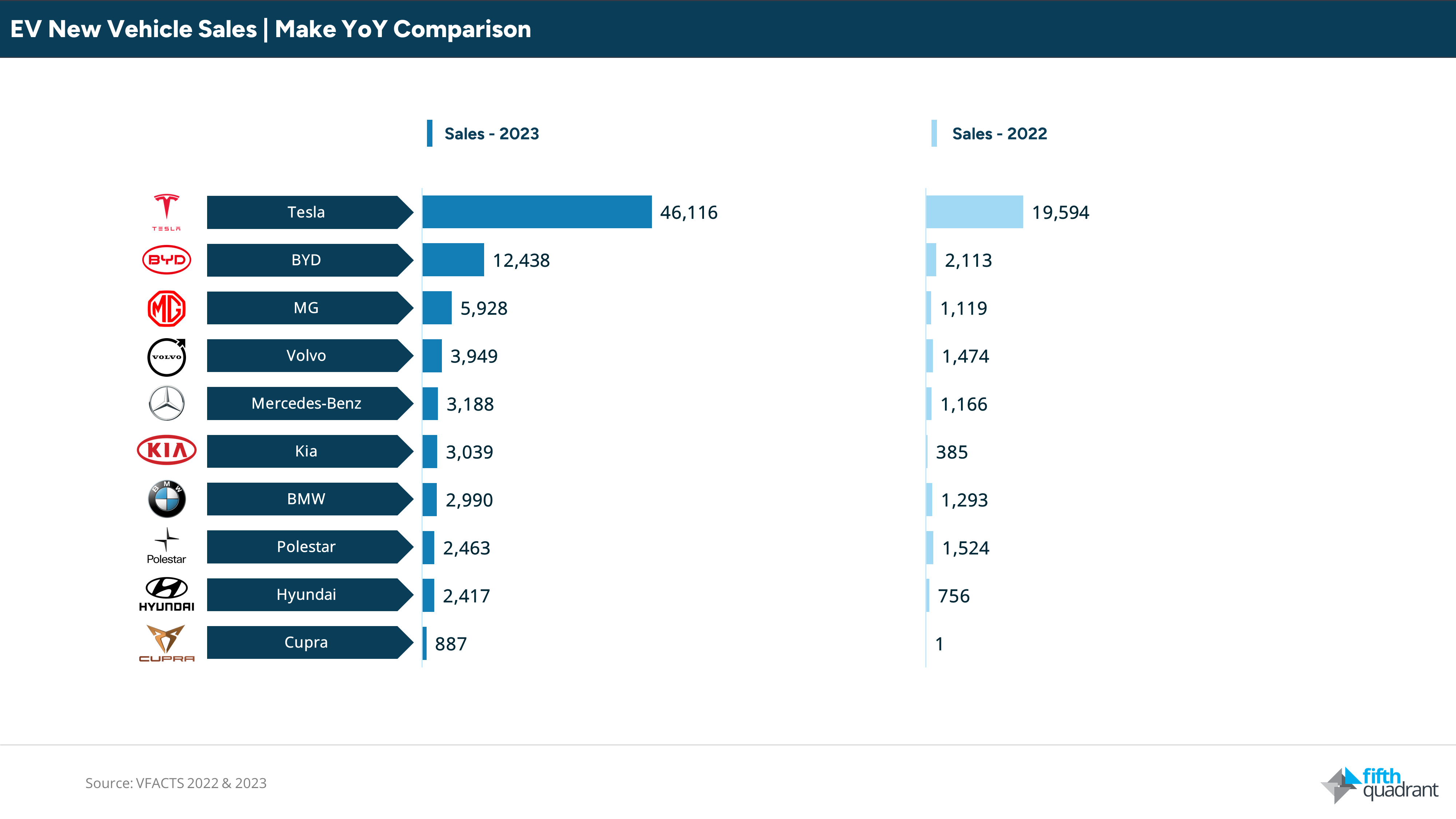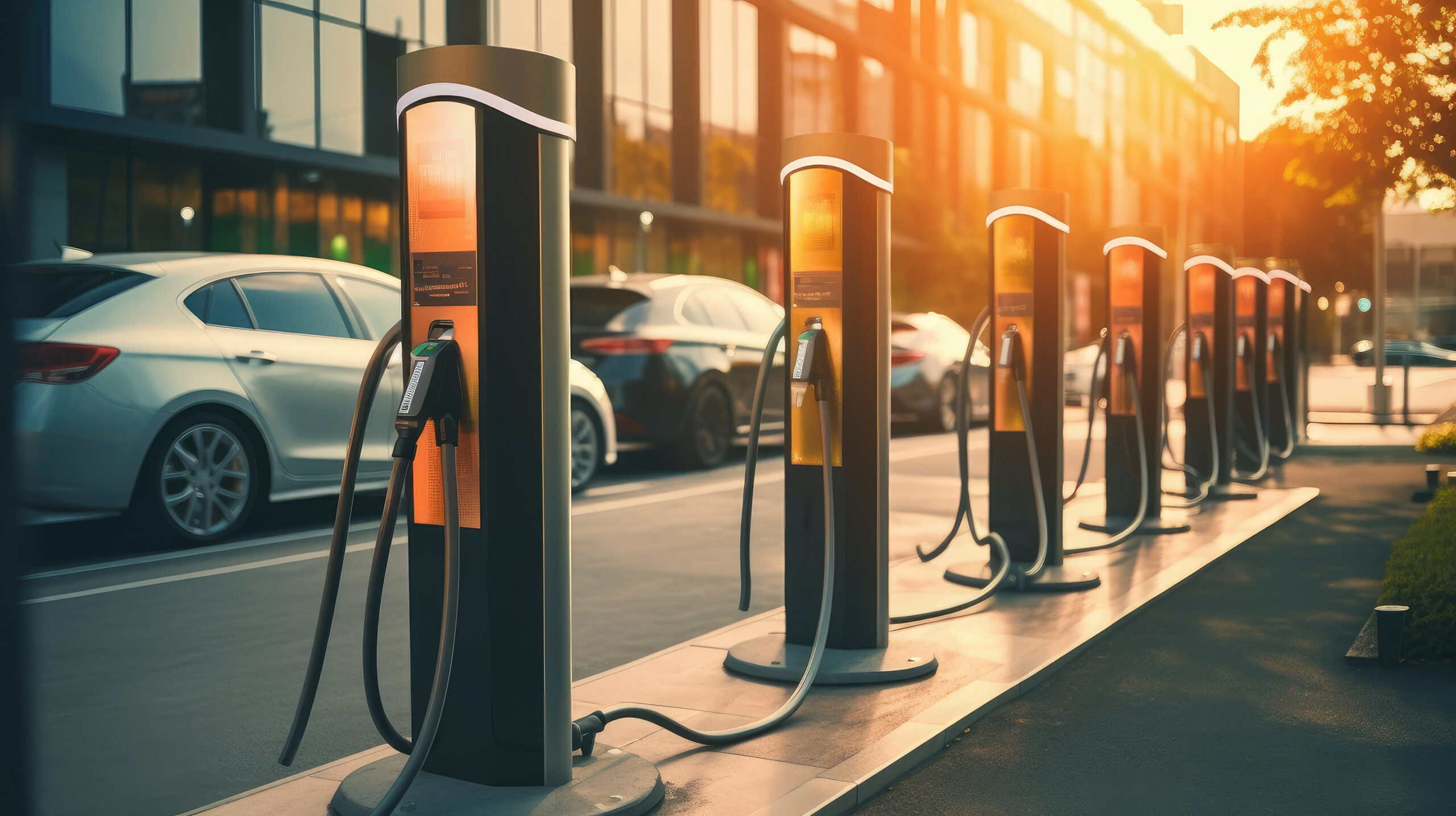Author: Matthew Beatty | Posted On: 17 Jan 2024
In 2023, Australians set a record by purchasing 87,430 new electric vehicles (EVs), making up approximately 7% of total sales for the year (a remarkable 161% surge from the 33,410 EVs sold in 2022). We also saw a huge increase in diversity with 27 brands now active in the Australian market, selling 61 unique models (and with many more still to come).
Similarly to the market more broadly, SUVs dominated passenger vehicles, capturing sales in a two to one ratio. Given the absence of volume light and heavy commercial options, their share remains negligible (~1%), but will grow as more suitable models are launched over the next 24-36 months.
top takeaways:
- EV sales in Australia skyrocket: Jumping 161% from 2022 to 2023, 7% of the market is now electric.
- Tesla still the leader, but challengers emerging: While Tesla held a 53% share (46,116 sales), diverse and affordable models from BYD and MG are creating a more competitive landscape.
- China producing the majority share of EVs: Reflecting global trends, more than80% of EVs sold in 2023 were produced in China, led by Tesla, BYD and MG.
- NSW remains the top EV state: NSW captured 33% of the national EV market, followed closely by Victoria at 25%.
- The future of EVs in Australia is bright: The 2023 figure of 87,430 is double the amount of the cumulative number of EV’s sold up until 2022 (approximately 43,000 units)
top makes
Tesla yet again led the way with 46,116 sales (up 135% from 19,594 sales in 2022), giving it just over half (53%) of total sales for the year. New entrant BYD has rocketed up the charts to sit in second place, boasting an impressive year of 12,438 sales from its three models.
MG secured the third spot on the podium with 5,928 vehicles sold, followed by Volvo (3,949 sales) and Mercedes-Benz (3,188). Completing the top 10 were Kia (3,039 sales), BMW (2,990 sales), Polestar (2,463 sales), Hyundai (2,417 sales), and Cupra (887 sales).

top models
As expected (and in line with its overall performance), Tesla secured first and second spot on the sales charts, with the Model Y (28,769 sales – top EV and third best-selling SUV overall), and Tesla Model 3 (17,347 sales). BYD landed the 3rd spot with the Atto 3 (11,042 sales), whilst the newly released MG 4 (3,134 sales), and Volvo XC40 Recharge (2,846 sales) closed out the top 5.
Completing the top 10 were the evergreen MG ZS EV (2,794 sales), Polestar 2 (2,463 sales), Kia EV6 (1,831 sales), Mercedes-Benz EQA (1,196 sales), and Volvo C40 Recharge (1,103 sales).

State breakdown
Electric vehicle sales are distributed relatively proportionately around the country, with New South Wales leading the way in 2023 with 28,954 sales (33% share of market). Victoria followed closely with 22,155 EV sales, constituting 25% of the total, while Queensland secured the third spot with 18,569 units and a 21% share.
Western Australia contributed significantly with 8,352 EV sales, representing 10% of the national market and South Australia recorded 4,345 EV sales, capturing a 5% share, Whilst the ACT and Tasmania demonstrated notable participation with 4% and 2% shares, respectively. The Northern Territory (NT) registered 282 EV sales, contributing 0.3% to the national total.

what next?
These results clearly show that EVs have made it into the mainstream, with 2024 set to be another record-breaking year for EV’s in Australia. Another 34 models are confirmed for release this year, with many Australians also keeping a keen eye on the electric utes being tested by a number of manufacturers. With that said, the overall market will correct downwards following 2023’s record result, and hybrid sales finished the year strongly, so we can expect a level of competition there too, targeting consumers who might not be quite ready to take the plunge.
If you’ve enjoyed this piece, you can download our year in review summary slides here, and don’t forget to keep an eye out for our regular updates on the Australian automotive industry.
Also remember that our b2b and consumer tracking research runs monthly. Click here to find out more, and feel free to get in touch if you’ve got questions that you’d like to answer.
Posted in Auto & Mobility, B2B, QN, TL, Transport & Industrial, Uncategorized

